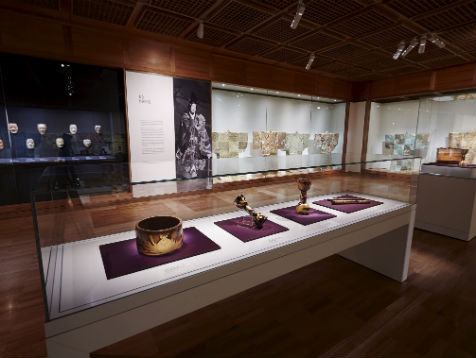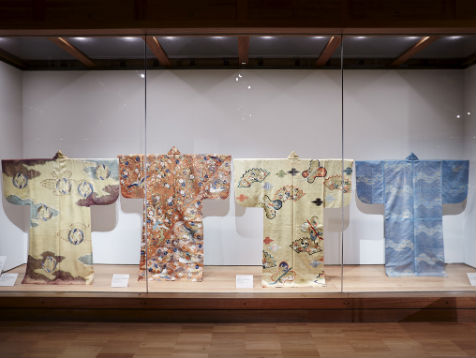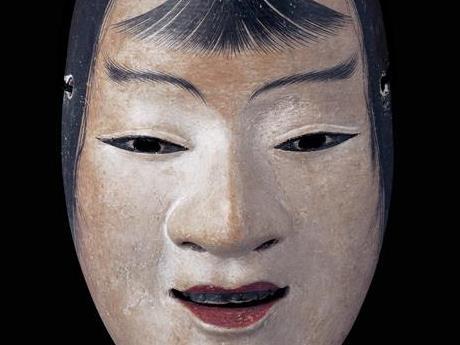Visitors to the Art Gallery of New South Wales (AGNSW) exhibition can look forward to seeing the most comprehensive collection of traditional Japanese theatre objects ever brought to Australian shores.
Documenting Japan’s oldest and continuous performing art tradition, nō and kyōgen theatre, Theatre of dreams, theatre of play features over 165 masks, costumes, musical instruments, paintings and songbooks that reveal the complexity and craftsmanship of this ancient storytelling art form.
Curator of Japanese Art at AGNSW Dr Khanh Trinh said the gallery worked with the National Noh Theatre, Tokyo, and the Agency for Cultural Affairs of the Government of Japan to develop the exhibition. ‘The amount of work that we now have here in Sydney has never been shown together outside of Japan,’ she said.
‘All the materials used in performances, such as costumes and masks, were created by master artisans using costly materials and highly developed weaving techniques, colour decoration and carving techniques.
‘The techniques seen within the artwork and the costume are just mind-blowing, and you can see all this up close, which is a treat for everyone. It will speak to people who would love to know more about traditional Japanese culture, and how theatre was enjoyed and produced in Japan 600 years ago.’

Installation view of Theatre of dreams, theatre of play: nō and kyōgen in Japan exhibition, Art Gallery of New South Wales, Sydney. Photographer: Mim Stirling
Nō and kyōgen theatre has been an integral part of the Japanese social elite and Samurai culture since the 14th Century. ‘Nō is a more symbolic drama, that deals with subjects from classical literature and legends,’ said Trinh.
‘All the characters are ghosts who have come back to the living world, because they’re still attached to the living world by very strong emotions that they could not resolve, such as jealousy, unrequited love, anger or injustice.’
While characters within nō plays echo strong religious undertones of Buddhism, kyōgen plays are recognised as lighter comedies. They would have appealed to lower and middle-class audiences, telling ‘commoner stories’ with recognisable dynamics including masters and slaves, husbands and wives, and fathers and sons-in-law.
The exhibition examines the distinctive design and stagecraft styles that separate the two forms. ‘In nō theatre, all the costumes are made of very costly materials like silk, embroidery and gold foil, whereas in kyōgen the costumes are much simpler, there are less types and the materials used are much more modest,’ said Trinh.
Integral to both styles is the use of masks. In nō they convey a profound sense of mystery and beauty. Whereas in kyogen, they are ofan exaggerated nature and primarily designed to make an audience laugh.
‘Some of the masks in the exhibition date (back) to the 15th Century, which are still in use today, and created at that time probably by commission and handed down generation by generation in these very elite circles,’ said Trinh.
‘The mask is sometimes considered sacred to nō actors. In nō theatre, not all of the actors can wear the masks – only the lead actors of the stage – so it was in the hierarchy of nō performers. Elite actors at the highest rank were worshipped.’
Trinh said the title of the exhibition was inspired by the structure of the nō plays themselves, which often began with a vision or a dream. ‘The main character would appear in the vision or a dream to a supporting character in a disguise, only to reveal his true character in the second act which is kind of a flashback.’

Installation view of Theatre of dreams, theatre of play: nō and kyōgen in Japan exhibition, Art Gallery of New South Wales, Sydney, showing costumes from the National Noh Theatre and Agency of Cultural Affairs collection. Photographer: Mim Stirling
Theatre of dreams starts in a large room dedicated to the nō theatre. ‘You will burst into this world of a very dreamlike, profound solemnity and very dignified atmosphere,’ Trinh said.
‘The second part will be dedicated to aspects of performances. We have a projection that shows excerpts of nō and kyōgen plays, and also paintings that depict nō performances throughout the ages.The exhibition will end with a room dedicated to the kyōgen theatre, which is more playful. It’s like you come back to reality and end the exhibition with a smile,’ she said.
Supporting the exhibition will be a rich program of events, public talks and guided tours. For Rhythms of nō: music, chant, dance on 29 June, nō and kyōgen expert Richard Emmert will present a lecture that reveals special insights into the plays. ‘This will be very instructive to people who are not very familiar with nō theatre,’ said Trinh.
School holiday sessions of The art of Japanese theatre will give participants an opportunity to create their own nō and kyōgen masks following a tour of the exhibition.
A weekly lecture series, Noh to now: traditions and counter-traditions in Japanese performance, will be held across five Wednesday evening sessions during July and August, and is sponsored by the Japan Foundation, Sydney.
‘That lecture series will cover all the types of Japanese theatre. Not only the nō, but also the Kabuki theatre and traditional Butoh dance,’ said Trinh.
A symposium to the exhibition, on Saturday 2 August, features international experts who will explore both the historical and contemporary practice of nō
theatre. Speakers include curator Kadowaki Yukie from the National Noh Theatre, Professor Monica Bethe and Dr Trinh herself.
Theatre of dreams, theatre of play is on at the Art Gallery of New South Wales 14 Jun to 14 Sep 2014.
*Due to the fragile nature of the works, the exhibition will be closed 28-30 July for conservation purposes.
For tickets and more information visit the Art Gallery of New South Wales website.





